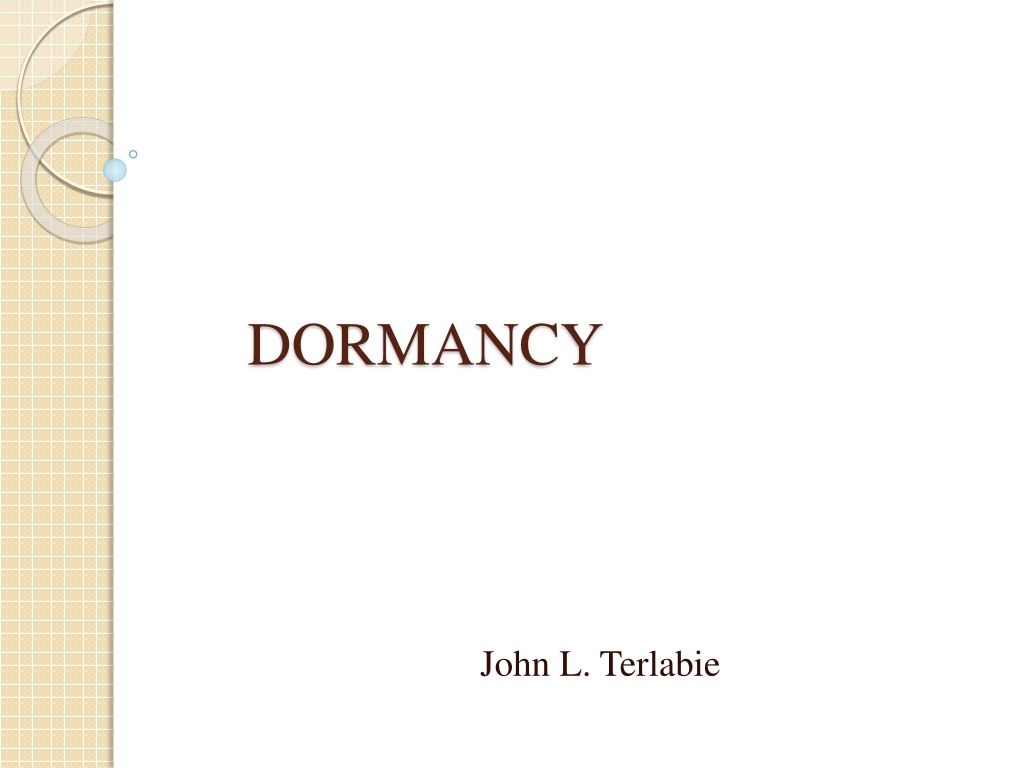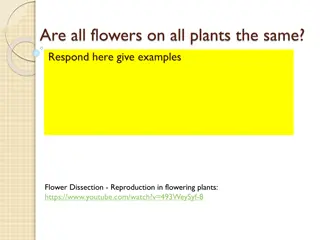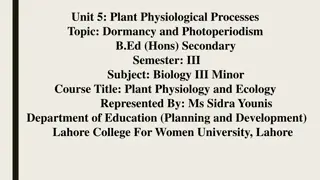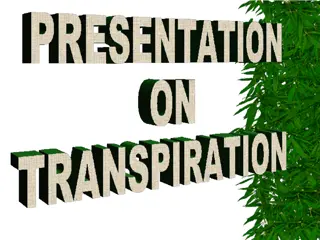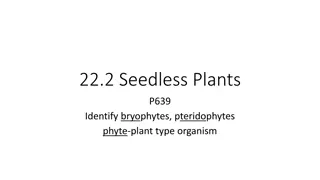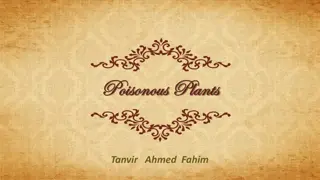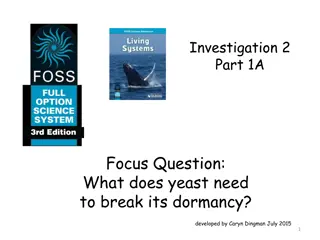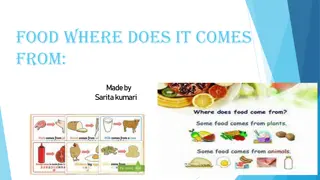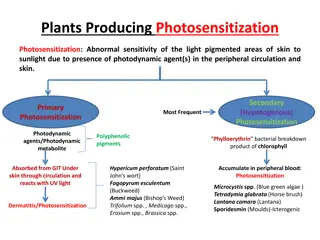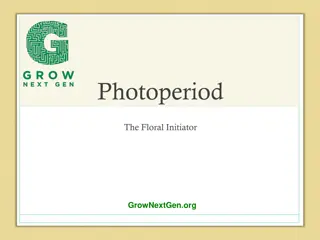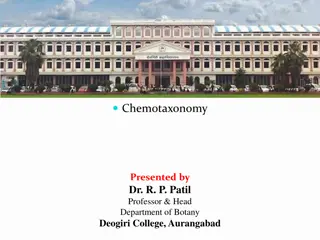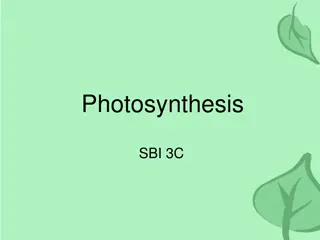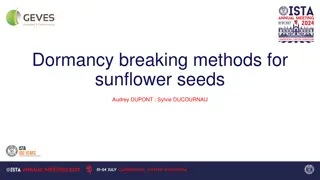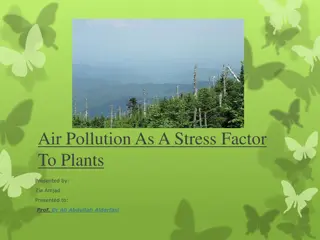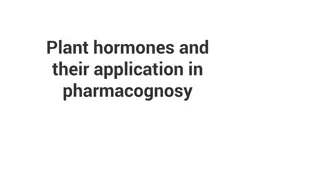Understanding Dormancy in Plants: Causes and Implications
Dormancy in plants, involving seeds and buds, is a state where growth is temporarily halted due to internal or external factors. Factors like immature embryos, impermeable seed coats, and growth inhibitors contribute to seed dormancy. The presence of inhibitors like abscisic acid and the influence of seed coats from specific plant families can regulate germination processes. This state is crucial for plant survival and propagation.
Download Presentation

Please find below an Image/Link to download the presentation.
The content on the website is provided AS IS for your information and personal use only. It may not be sold, licensed, or shared on other websites without obtaining consent from the author. Download presentation by click this link. If you encounter any issues during the download, it is possible that the publisher has removed the file from their server.
E N D
Presentation Transcript
DORMANCY John L. Terlabie
DORMANCY Dormancy refers to the state in which a living plant organ i.e. bud, seed, tuber or bulb fails to exhibit growth, even when environmental conditions are considered favorable. It also refers to a state in which growth is temporarily suspended. It may be caused by Innate or Environmental Factors. Innate- those within the organ; Environmental-those outside the organ (external).
Dormancy contd. Dormancy occurs in both seeds and buds and may last for seconds, minutes/years In a stricter context, dormancy pertains to a condition where the inhibition of growth is internally controlled by factors restricting water and nutrient absorption, gas exchange, cell division and other metabolic processes necessary for growth.
Dormancy contd. Thus dormancy is a state of the seed and not of the environment. True dormancy therefore refers to conditions within the seed that prevent germination.
SEED DORMANCY This may be caused by many factors and these include: immature embryo, impermeable seed coat to water and gases, mechanical resistance to the growth of the embryo due to the hard seed coat, special requirements for temperature or light, the presence of growth inhibitors in the embryo, the testa, endosperm and pericarp.
Seed Dormancy contd. Examples of growth inhibitors include, abscisic acid, cinnamic acid, ferulic acid, coumarin, ammonia, caffeic acid, hydrogen cyanide, phenolic glucosides. Some seeds also require some time after shedding from their parent plants before they germinate such seeds require a period of after-ripening .
Seed Dormancy contd. The seed coat is one of the important factors for many seeds. The hard seed coat in malvaceae, convolvulaceae and fabaceae is responsible for the dormancy found in these families. The seed coats may regulate germination by establishing a permeability barrier and interfering with these processes; uptake of H2O required for imbibitions: - i. adsorption of H2O to hydrolyze enzymes in seed; a)
Seed Dormancy contd. subsequent radicle protrusion; b) it also interferes with gaseous exchange and the outward diffusion of endogenous growth inhibitors. ii. The hard seed coat may be broken artificially by scarification which involves nicking or slightly cracking the seeds or dipping them a concentrated acid. Example: seeds may be soaked in sulfuric acid for a few seconds to a few hours which eat away the hard seed coat or used alcohol for seeds with waxy seed coat.
IMMATURE EMBRYO Immature Embryo can also cause dormancy in seeds. In this case, the embryo is immature. When the seed comes out of the parent, it has not attained complete development and requires time. When the seed comes out of the parent, it needs to mature before germination takes place.
Immature Embryo contd. E.g.s include Ginkgo biloba, Fraxinus nigra and Ilex opaca usually need storage before they can germinate. They often require a period at an appropriate temperature after imbibition. In some seeds the embryo may be matured but will not germinate immediately after harvest but will do so after storing for some time. These seeds will not germinate until a certain amount of time has passed regardless of how they are treated.
Immature Embryo contd. During the storage period, physiological processes go on but are greatly reduced. Cereals need dry storage at normal temperature while seeds of temperate species need cold storage for after ripening before they can break dormancy. E.g.s include Amaranthus retroflexus, Malva craispa, M. silvestras. Other seeds require various treatments before they can germinate. For eg. photoblastic seeds need light to break their dormancy.
Immature Embryo contd. Examples of such seeds include Lactuca, sativum, Nicotiana tabaccum, Lepidium, virginicum. Many chemicals are known to influence the germination of dormant seeds example potassium nitrate (KNO3) can replace the requirement for light and particular temperature regimes in large numbers. GA (GibberellicAcid) has been shown to be capable of replacing requirements of light, low temperature and alternation temperatures in a lot of species.
Immature Embryo contd. GA is active in breaking seed dormancy induced by a number of agents such as darkness, osmotic effects, high temperatures and coumarin. Other chemicals that influence dormancy include: cytokinin, thiourea, thiocyanate, glutathione. Seeds whose germination is prevented or retarded by light are called negative photoblastic.
Immature Embryo contd. Those that require light to break their dormancy are called Positive Photoblastic. There are two types of positive photoblastic: Type1:- They are those that respond to brief exposure to red light to break dormancy. These types are called photosensitive. Type 2:- These are called photoperiodic and these require repeated exposure to light to be able to germinate.
Immature Embryo contd. Both types are controlled by light pigment called phytochrome. Photosensitivity in seeds is often induced. For example lettuce; the inductive agents may be temperature, water stress or exposure to certain chemicals. In all cases, photosensitivity in seeds is lessened by germinating the seed at low temperature.
Immature Embryo contd. In many species, dormancy is broken by exposing most seeds to low temperature between 0 c to 10 c for anything from 7 to 108 days and this is termed Stratification. There are extensive list of optimum temperature and period or time for stratification include: avena, fatua, Fraxinus e.g. Betula, pubescens. Palm nuts require fire to break dormancy.
Immature Embryo contd. In certain species, H2O and O2are unable to penetrate because the entry is blocked by a cork- like fillings called Strophiolar plug in a small opening called Strophiolar cleft in the seed coat. These seeds require vigorous shaking to dislodge the plug.
MECHANISM OF DORMANCY It has been suggested that the blocking of growth is due to restriction of respiration due to the restriction of exchange of air within the organ. This may be the reason in some cases for example where the seed coat is hard, the coat may be impermeable to gases. In restricting respiration, there would be less energy available for growth.
Mechanism contd. This may be possible in some buds that are enclosed by bud scales example Ficus. However, in naked buds, this would not apply hence there may be other factors responsible for dormancy. In certain seeds, there is the presence of impermeable membranes either in the pericarp, the seed coat or sometimes even in the endosperm. All the seeds that form a barrier that is impermeable to H2O and O2intake may impose dormancy.
Mechanism contd. Another variation is found in certain seeds. In another instance , a membrane layer may form around the radicle which interferes with the maximum intake of H2O. It may also present a physical barrier to the expansion and protrusion of the radicle during germination. One factor which also imposes dormancy in seeds is the presence of inhibitors.
Mechanism contd. The idea of presence of inhibitors comes from the work of Molisch (1929). He worked with some fleshy seeds and succulent fruits example tomato. He observed that in some fresh fruits, the seeds did not germinate in situ but germinated when removed from the fruit. He suggested the cause of dormancy may be due to the presence of an inhibitor in the fleshy fruit.
Mechanism contd. He was later criticized by some workers that the failure of the seeds to germinate within the fruit was due to osmotic concentration of the juice. However, when the juice is diluted even with low osmotic concentration, there is still seed dormancy. It was later found out that phenolic substances present in the tomato juice influenced tomato seed dormancy.
Mechanism contd. Researchers have been able to isolate inhibitory substances from seeds. The inhibitors are either isolated either from the pericarp in the case of rice. From the endosperm, the seed coat (testa). This therefore confirms to Molisch s suggestion that inhibitors are present in seeds and can cause dormancy.
Mechanism contd. It was found out that, the inhibitor is water soluble. In the case of these seeds in which the inhibitor is present in the pericarp or testa, the seeds germinate when they are washed. Hemberg (1949) using potato tubers, suggested that dormancy in the buds of potato tuber is due to an inhibitor.
Mechanism contd. He demonstrated this by using extracts on wheat coleoptiles, which was able to inhibit the wheat coleoptiles tip growth. When the potato tuber is treated with ethylene chlorohydrine, the dormancy is removed within a short period of time. He observed that when the buds are emerging from dormancy, the extracts showed little inhibitory effects on the wheat coleoptiles growth test.
Mechanism contd. From these studies, he postulated that when the bud is emerging from dormancy the level of inhibitory principle decreases, while it increases when the bud is entering into deep dormancy. Researchers have been able to identify Rf value of the inhibitor (0.7 0.8). It is acidic in nature however the chemical nature is unknown but is called -inhibitor.
DORMANCY IN VARIOUS ORGANS Rhizomes:- E.g. lily of the valley (Convallavia najalis) Corms:- E.g. Gladiolus Bulbs:- E.g. Alum cepa, Tubers:- E.g. potatoes Bud:- Buds of aquatic plants show dormancy. In aquatic plant example Utricularia, bud dormancy is induced by short day in association with high temperature. In onions, dormancy is prolonged by long day and dormancy is broken by cool temperature.
Dormancy In Various Organs...contd With Gladiolus, warm temperature induces dormancy but chilling breaks the dormancy. Then warm temperatures break the dormancy in potatoes.
SIGNIFICANCE OF DORMANCY * It affects rate of production in certain industries e.g. Malting industries *Loss of food Most cereals like maize, rice and wheat, if they germinate immediately after harvest will be lost as food. *Bud dormancy protects plants against frost. *Dormancy ensures survival of young ones when conditions are not favourable.
Significance Of Dormancy...contd. * Dispersed seeds do not germinate under harsh conditions, but do so when conditions are favourable. Export commodities such as onion, potatoes etc. will lose their value if they germinate before they get to prospective buyers Prevents immediate sowing after harvesting. * Lots of money is needed to break dormancy (using chemicals).
SEED GERMINATION It is defined as the process starting from the imbibition of H2O by the seed and ending with the protrusion of embryonic root (radicle). Germination is the resumption of metabolic activity and growth by the tissues of the seed involving rehydration, utilization of nutrient reserves and the gradual development of synthetic systems which enable the young plant/seedling to assume an autotrophic existence.
Seed Germination contd. The extent and rate at which germination processes occur in a non-dormant seed are affected by a lot of factors. Among the important factors are light, temperature, CO2 and factors influencing the availability of H2O. All these factors can favor or inhibit germination in their natural environment.
Seed Germination contd. Hence the capacity of the seed to germinate and the time at which it does so are inevitably determined by a number of factors acting upon it.
FACTORS AFFECTING GERMINATION Seed Viability: -Ability of seed to germinate. Viability is genetically determined and modified by the environment Viability may be as long as 90 years or as short as few months or few weeks. (Longevity is the period for which a seed remains viable)
FACTORS AFFECTING GERMINATION...contd. SEED VIABILITY PERIOD Cassia bicapsularis 87 yrs Ipomea sp. 43 yrs Ulmus campestris 6 months Trifoliumpretense 81 yrs Acer saccharinum few weeks to months Salix japonica
FACTORS AFFECTING GERMINATION...contd. Water: - Germination starts with imbibition and depends on the: composition of the seeds permeability of the seed coat and availability of water. Imbibition is also temperature dependent; it increases with increase in temperature. The medium in which the seed germinates may also determine the rate of imbibition. E.g. A seed in saline conditions.
FACTORS AFFECTING GERMINATION...contd. Imbibition is a physical process and therefore depends on the colloidal properties of a seed. The most important component is the protein portion. However, other components play a role and these are: mucilage, cellulose and pectin. The process of imbibition may be slowed down by the saline conditions which may create an osmotic potential to prevent H2O uptake by the seed.
FACTORS AFFECTING GERMINATION...contd. It may also create the conditions that promotes the entry of ions which may be toxic to the embryo or the developing seedling. Whereas the seeds of halophytes are adapted to saline environment, those of the non-halophytes have variable self-tolerance limits with respect to germination in that environment. Temperature: - Temperatures being high and low affect germination. Different seeds have different temperature ranges where optimal germination occurs.
FACTORS AFFECTING GERMINATION...contd. The percentage of any seed to germinate is maximum at the optimal temperature for that species. As temperature declines or advances away from the optimal temperature, the percentage seed germination decreases and the number of days for germination also increases
FACTORS AFFECTING GERMINATION...contd. The temperature at which different seeds germinate and the range within which they germinate depends on the: Source of seeds, Genetic differences within a given species/ varietal differences and also on the Age of the seeds. Alternating temperatures have been found to increase germination of certain seeds. Examples of such seeds are: Nicotiana tabaccum, Rumex crispus, Poa trivialis, Cynodon dactylon.
FACTORS AFFECTING GERMINATION...contd. Light: - light affects the germination of some seeds. The fact of light is that most plants need light to grow to keep them healthy but not all plants need light to germinate, some seeds find light a hindrance to germination. Based upon this, seeds can be divided into those that germinate only in the dark, seeds that can germinate only in continuous light and seeds that will require a brief exposure to light and those that will germinate in both light and darkness.
FACTORS AFFECTING GERMINATION...contd. It has now been established that red light stimulates germination while far red light inhibits germination. The action spectrum is closely associated with the absorption of light reception in plants called the phytochrome. Phytochrome is the light pigment in plants and it exists in two inter-convertible forms- Pr and the Pfr form.
FACTORS AFFECTING GERMINATION...contd. It is first synthesized from amino acid in the Pr form. The Pr form converts into the Pfr form when it is exposed to red light. The Pfr form is the active form that induces biological responses. The Pfr is converted back to the Pr when it is exposed to the far red light or when in darkness. In darkness, the Pfr is reversed to the Pr or it is destroyed.
